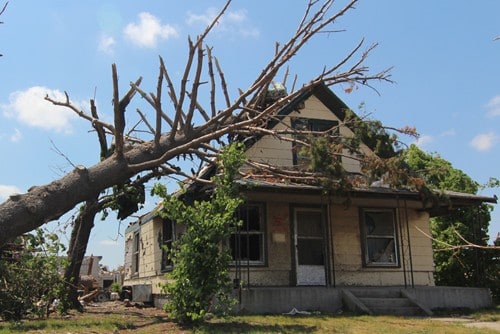The snow comes down, melts and then freezes again before the next storm hits. This grueling winter cycle makes it difficult to maintain your business property—especially in colder, northern climates. If certain steps are not taken, you run the risk of personal injury and serious property damage. Here are some tips for staying on top of winter weather property risks.
Preventing Slips & Falls
The average hospital cost for a fall injury is $35,000, according to the Center for Disease Control. Slips and falls are inherently more common in the winter months, especially among older adults. In order to protect yourself, your employees and your guests, it’s important to clear snow as soon as it falls and to melt ice as soon as it forms.
Snow Clearing & Maintenance – Hire a snow plow to clear your driveway or parking lot, or invest in a snow blower or snow shovel. It’s a good idea to keep a snow shovel and a bucket of salt or sand near the front door so that you can frequently clear slick snow and slush. Always display wet floor signs to warn guests of slick surfaces.
Key points to remember:
- Snowplow service
- Snow blower
- Snow shovel
- Rock salt or sand
- Anti-slip mats
- Wet floor signs
Snow on the Roof
Unfortunately, there’s no hard and fast rule for telling how much snow is too much for your roof to handle. There are several factors that come into play, including the density of the snow, the pitch of the roof and the integrity of the structure.
However, some roofs are at higher risk than others:
- Flat or slightly pitched roofs
- Roofs covered in unevenly distributed drifts
- Shallow roofs below steeper, higher roofs
- Roofs that are exposed to high winds
If you’re afraid the weight of the snow is too much for your roof to support, take a look in the attic. If the rafters appear bent, then it’s definitely time to hire a professional or invest in a roof rake with an extension pole to do it yourself. It’s always a good idea to sweep your roof on a regular basis to prevent large drifts from accumulating.
Frozen Downspouts & Gutters
The downspouts are often overlooked when it comes to snow and ice removal. It’s important to clear snow from the base of your downspouts so that roof runoff can flow freely during a thaw. Downspouts that are not clear run the risk of freezing solid and overflowing. Gutters may also freeze and become damaged under the weight of the ice.
Lighting
Daylight is limited in the winter months. It’s likely dark when employees arrive and dark again by the time they leave. Prevent slips and falls by installing adequate lighting in highly trafficked areas, like the parking lot and entrances. Keep employees in mind, too. They may need some extra light for taking garbage and recycling out to their appropriate dumpsters.
HVAC
Your heating system works harder than ever in the winter, and HVAC failure can lead to busted pipes exposed to freezing temperature over an extended period of time. Regular maintenance is recommended in order to prevent breakdowns and increase efficiency. Hire an HVAC technician to inspect and perform maintenance every fall and spring. On a more routine basis, you’ll want to check areas around your heating units to make sure no flammable or combustible materials are in the area. And if space heaters are used, keep flammable materials away and be careful not to overload electrical circuits.
Emergency Response Team
Create an Emergency Response Team to keep an eye out on the forecast for any upcoming weather-related concerns. The team should also be responsible for alerting management and ensuring that all of the tools and equipment are in place to handle a winter storm. And don’t forget to make communication a part of your response plan. Let employees know the protocol for work closures due to dangerous weather conditions. Consider communicating through simultaneous channels, such as phone calls, your company website, social media, email blasts and group texts.
Note: These steps do not supersede local, state, or federal regulations. This blog article is for general information only and is not intended to provide, and should not be relied upon, for ergonomic, training or medical advice in any particular circumstance or fact situation. For more information, please contact your local Loss Control Consultant at 800.257.1900


